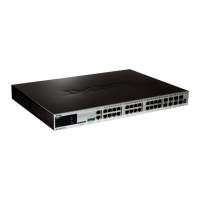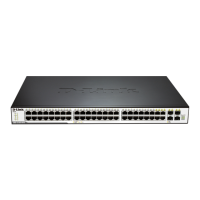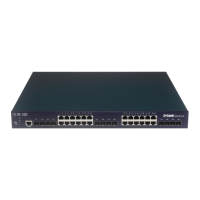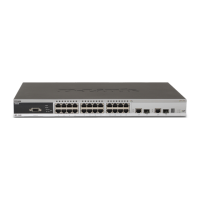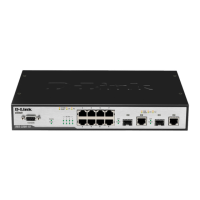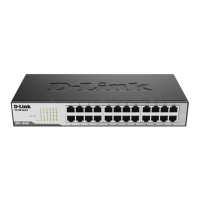xStack DGS-3400 Series Layer 2 Gigabit Ethernet Managed Switch
Done Timer
Specifies the maximum amount of time a router can remain in the Switch after
receiving a done message from the group without receiving a node listener report.
The user may specify a time between 1 and 16711450 with a default setting of 2
seconds.
Querier State
Choose Enabled to enable transmitting MLD Snooping Query packets or Disabled to
disable. The default is Disabled.
Querier Router Behavior
This read-only field describes the current querier state of the Switch, whether
Querier, which will send out Multicast Listener Query Messages to links, or Non-
Querier, which will not send out Multicast Listener Query Messages.
State
Used to enable or disable MLD snooping for the specified VLAN. This field is
Disabled by default.
Fast Done
This parameter allows the user to enable the fast done function. Enabled, this
function will allow members of a multicast group to leave the group immediately
when a done message is received by the Switch.
NOTE: The robustness variable of the MLD snooping querier is used in creating the following
MLD message intervals:
Group Listener Interval – The amount of time that must pass before a multicast router
decides that there are no more listeners present of a group on a network. Calculated as
(robustness variable * query interval ) + (1 * query interval).
Querier Present Interval – The amount of time that must pass before a multicast router
decides that there are no other querier devices present. Calculated as (robustness variable *
query interval) + (0.5 * query response interval).
Last Listener Query Count – The amount of group-specific queries sent before the router
assumes there are no local listeners in this group. The default value is the value of the
robustness variable.
Click Apply to implement changes made. Click the Show All MLD Snooping Entries
link to return to the MLD Snooping Settings
window.
MLD Router Port Settings
The following window is used to designate a port or range of ports as being connected to multicast enabled routers. When IPv6
routing control packets, such as DVMRP, OSPF or RIP, or MLD Query packets are found in an Ethernet port or specified VLAN,
the Switch will set these ports as dynamic router ports. Once set, this will ensure that all packets with a multicast router as its
destination will arrive at the multicast-enabled router, regardless of protocol. If the Router’s Aging Time expires and no routing
control packets or query packets are received by the port, that port will be removed from being a router port.
To configure the settings for MLD Router Ports, click L2 Features > MLD Snooping > MLD Router Port Settings, which will
open the following window.
Figure 7- 33. Router Port Settings window for MLD
To configure the router ports settings for a specified VLAN, click its corresponding button, which will produce the
following window for the user to configure.
146
